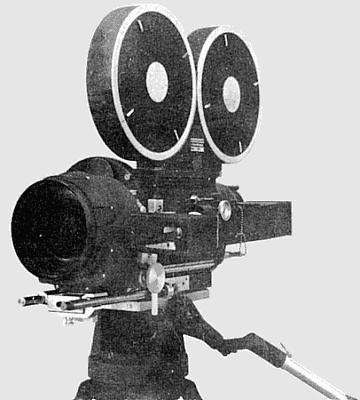moves that seem natural, and devising action to keep the scene interesting, there is no great problem in adapting the camera to the scene so rehearsed. I believe the camera should be fitted to the action and not the reverse as is so frequently done. After all, we are telling a story and the audience should never be aware of the techniques involved. After the geography of the set has been established, which is frequently done by the characters entering the scene in a long shot, I like to move in to a medium shot which covers the action. Now if the action is so staged that the characters are manoeuvered to positions where the persons having the most important dialogue is in an advantageous camera position, the camera can move forward or back and pan when necessary with the action as long as it is desirable to hold the scene.
![]() I believe that it is more comfortable, interesting and natural to the
spectator if scenes are sustained and a minimum of cuts are made. A
vast screen area, approaching the periphery of vision requires new
adjustment of the eyes each time the scene is changed - the wise
Director will stage his scenes to best use the advantages of this new
technique. These advantages are great for no longer must we confine
the actors to areas forward and backward from the camera, but may now
also use lateral movement. Spreading out of the action is what is done
in stage productions, and indeed in CinemaScope pictures the
technique is like that of the theatre with the added advantage of being
able to move in with the camera to accentuate the most important
portions of a scene. Speaking of moving the camera, all of the
established methods of motivating the camera - cranes, dollies, etc.-can
be utilized provided they are smooth because any unsteadiness
becomes exaggerated on the wide screen.
I believe that it is more comfortable, interesting and natural to the
spectator if scenes are sustained and a minimum of cuts are made. A
vast screen area, approaching the periphery of vision requires new
adjustment of the eyes each time the scene is changed - the wise
Director will stage his scenes to best use the advantages of this new
technique. These advantages are great for no longer must we confine
the actors to areas forward and backward from the camera, but may now
also use lateral movement. Spreading out of the action is what is done
in stage productions, and indeed in CinemaScope pictures the
technique is like that of the theatre with the added advantage of being
able to move in with the camera to accentuate the most important
portions of a scene. Speaking of moving the camera, all of the
established methods of motivating the camera - cranes, dollies, etc.-can
be utilized provided they are smooth because any unsteadiness
becomes exaggerated on the wide screen.
![]() As scenes are more interesting when the players are in different
planes of depth, the usual problem of depth of focus is posed. I have
found that a practical solution is to work at a one thousand foot candle
key for interior day scenes.
As scenes are more interesting when the players are in different
planes of depth, the usual problem of depth of focus is posed. I have
found that a practical solution is to work at a one thousand foot candle
key for interior day scenes.
